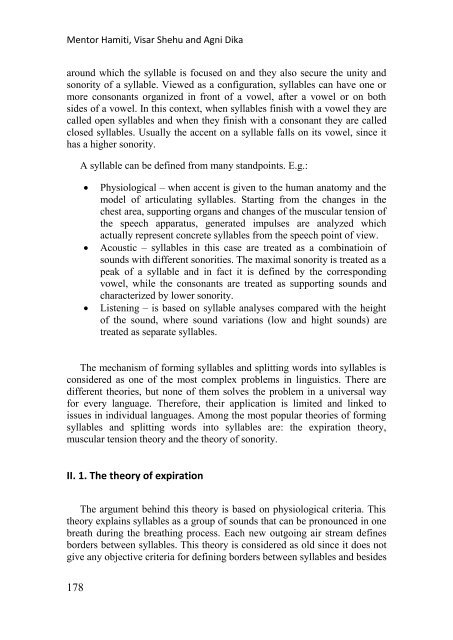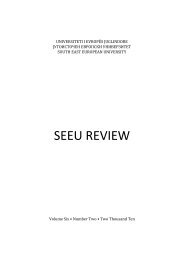SEEU Review vol. 5 Nr. 2 (pdf) - South East European University
SEEU Review vol. 5 Nr. 2 (pdf) - South East European University
SEEU Review vol. 5 Nr. 2 (pdf) - South East European University
You also want an ePaper? Increase the reach of your titles
YUMPU automatically turns print PDFs into web optimized ePapers that Google loves.
Mentor Hamiti, Visar Shehu and Agni Dika<br />
around which the syllable is focused on and they also secure the unity and<br />
sonority of a syllable. Viewed as a configuration, syllables can have one or<br />
more consonants organized in front of a vowel, after a vowel or on both<br />
sides of a vowel. In this context, when syllables finish with a vowel they are<br />
called open syllables and when they finish with a consonant they are called<br />
closed syllables. Usually the accent on a syllable falls on its vowel, since it<br />
has a higher sonority.<br />
A syllable can be defined from many standpoints. E.g.:<br />
<br />
<br />
<br />
Physiological – when accent is given to the human anatomy and the<br />
model of articulating syllables. Starting from the changes in the<br />
chest area, supporting organs and changes of the muscular tension of<br />
the speech apparatus, generated impulses are analyzed which<br />
actually represent concrete syllables from the speech point of view.<br />
Acoustic – syllables in this case are treated as a combinatioin of<br />
sounds with different sonorities. The maximal sonority is treated as a<br />
peak of a syllable and in fact it is defined by the corresponding<br />
vowel, while the consonants are treated as supporting sounds and<br />
characterized by lower sonority.<br />
Listening – is based on syllable analyses compared with the height<br />
of the sound, where sound variations (low and hight sounds) are<br />
treated as separate syllables.<br />
The mechanism of forming syllables and splitting words into syllables is<br />
considered as one of the most complex problems in linguistics. There are<br />
different theories, but none of them solves the problem in a universal way<br />
for every language. Therefore, their application is limited and linked to<br />
issues in individual languages. Among the most popular theories of forming<br />
syllables and splitting words into syllables are: the expiration theory,<br />
muscular tension theory and the theory of sonority.<br />
II. 1. The theory of expiration<br />
The argument behind this theory is based on physiological criteria. This<br />
theory explains syllables as a group of sounds that can be pronounced in one<br />
breath during the breathing process. Each new outgoing air stream defines<br />
borders between syllables. This theory is considered as old since it does not<br />
give any objective criteria for defining borders between syllables and besides<br />
178

















